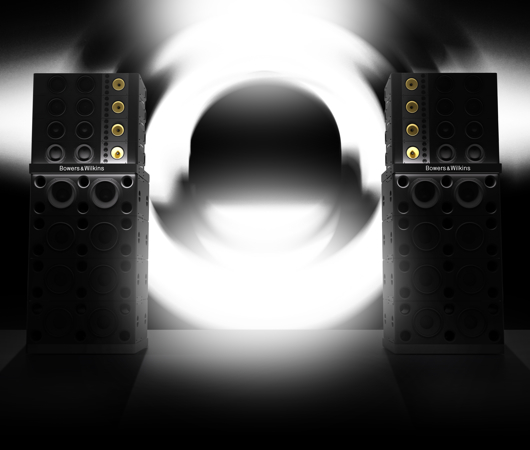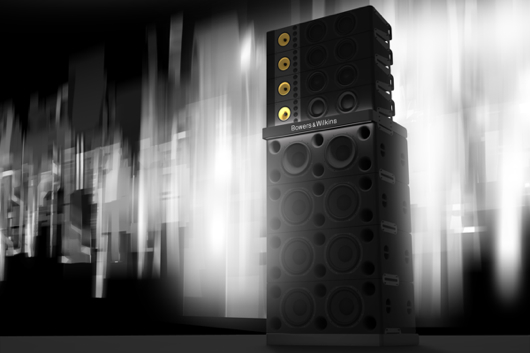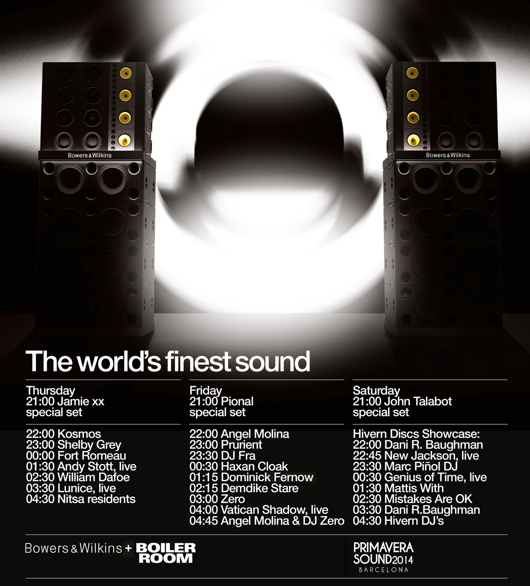On Blast – The Audiophiles at Bowers & Wilkins Discuss the Custom Soundsystem They’ve Built for Primavera Sound
The 2014 edition of Barcelona’s Primavera Sound festival kicks off tomorrow, the four-day event once […]

The 2014 edition of Barcelona’s Primavera Sound festival kicks off tomorrow, the four-day event once again bringing luminaries of the indie world and an impressive array of electronic talents to the city’s Parc del Fòrum. As part of the festival, British hi-fi speaker designers Bowers & Wilkins have created the Bowers & Wilkins Sound System, a colossal, one-of-a-kind speaker set that will power the festival’s appropriately titled Bowers & Wilkins + Bolier Room stage, which will host the likes of John Talabot, Andy Stott, Fort Romeau, Demdike Staare, and The Haxan Cloak, among others. Before XLR8R and the Primavera audience have a chance to experience this unique soundsystem—which will be housed inside an igloo-style tent designed by Igloovision—we spoke with former product manager and current brand manager at B&W, Danny Haikin, to discuss the inspiration behind the project and how the company hopes bringing “completely undistorted and uncompressed” audio to an electronic festival stage will help spread the gospel of “good sound.”
XLR8R: Could you give us a brief history of Bowers & Wilkins? When was the company founded?
Danny Haikin: Bowers & Wilkins is a 48-year-old British engineering and acoustics company. The company was started in England by a very passionate engineer named John Bowers in 1966, and he was just completely dedicated to making better sound—it was his entire life. The origins of the company is [in the realm of] high-end audio; in the ’70s we were mostly making products for serious, music-loving audiophiles, and from there, we began to expand.
What was the inspiration for the Bowers & Wilkins Sound System? Has the company done any sound reproduction on this large of a scale before?
We did it once before, actually. We made a soundsystem in the ’80s that toured with Coldcut for years, which was a completely black-ops project that the engineers used to do on their lunch breaks, and it sounded terrific. Generally, the inspiration for what we do is in part that we are just annoyed with bad sound. I think everyone that works at B&W, especially the engineers, are into it for the right reason—good sound.
The Bowers & Wilkins Sound System is more of an exercise than a business move—we thought it would be interesting for a moderate-sized festival audience to hear something that was completely undistorted and uncompressed, partly just to see that if the sound is amazingly clean and clear, and you can hear everything, how would it make an evening? We’ve put a huge amount of care into setting this system up, and we’ve got some goodwill from the DJs not to go completely nuts with their distortion and levels. [laughs]

How long was this project in the works?
I had wanted to do this for years, but I found it hard to get a mandate because people thought I was nuts. [laughs] But as the festival market has become so big, it became easier to convince people that we could potentially expose what we do to a large number of people in a very powerful way.
How long did it take to design and develop the soundsystem?
We ended up being able to put the soundsystem together in about six months, which is vastly less time than we usually spend making a new product—we usually work on a two-year basis. There is a whole lot you have to do to make a product to sell to somebody, but if you’ve got some interested engineers and you’re not too worried about market research…
Considering this not a commercial product, we were able to bypass a lot of those issues. You could really argue that this is a monstrously impractical system; it weighs four metric tons, and it requires a forklift and a cherry picker to assemble it—no PA installer would put this system in a huge arena. [laughs] But we’ve done it to make a point; some PA companies would possibly be aghast at the way we’ve done it, seeing as we haven’t used horns or those sorts of normal things one would use. Unfortunately, those things all tend to have a pretty deteriorating effect on sound.
The line-up for the Bowers & Wilkins + Boiler Room stage is entirely focused on electronic music. Would you say the soundsystem was designed specifically with electronic music in mind?
People often think that electronic music doesn’t require good sound, and I think there is a point to be made that it really does. Sounds that come out of synths and computers potentially have far more details than the sound that goes into microphones, so I think it’s just as important to reproduce it more clearly. Also, we wanted this to be a true test of the system in terms of dynamic range and bass-output control, so we chose a fairly heavy-duty set of co-conspirators in the DJs and artists we’ve invited to play. I’m just thinking of the Haxan Cloak’s technical rider as we talk about this. [laughs]

Is the igloo-like structure you’re using at Primavera built to enhance or shape the acoustics in any way, or is that purely an aesthetic aspect?
The igloo wasn’t a sound consideration, but the festival was very keen to have an interesting experience, and the igloo acts as a sort of planetarium. It has this amazing three-dimensional projection system and we’ve engaged three visual artists to VJ for the duration of the festival. They’ve come up with some sort of bespoken artwork that is of an acoustic nature, visually, to augment the sound. But no, it’s not a special acoustic structure. In fact, the system might sound better completely outdoors, until it rained. [laughs]
Ideally, what would you like people to take away after having heard the soundsystem?
One of the things a really good system with well-engineered cabinets and well-engineered drivers does is it propels music at such a different pace rhythmically. It would be great for people to have an awareness that the music is literally moving them more. A lot of the harmonic and percussive information that is often obscured in a live scenario—but is really important, particularly to music that is electronic and with less overt melody—will be there, and it really makes the music more interesting when you hear the whole sound spectrum. It’ll be great if people notice; whether they will or not, we’ll see. [laughs] I honestly think they will; for all the people that have heard it so far, it’s so obviously a completely different type of animal to a regular system.
Does B&W have other plans for the system? Are you looking to take it around to more festivals following Primavera?
We want to vary the things that we do with the soundsystem. We want different groups of people to be able to hear it. We’ll be taking it to WOMAD, a world music festival in England, and we’ll potentially be doing some broadcasting of operas and symphonies as well with it. But we’ll see how Primavera goes, as I’d like to continue using the soundsystem for more events like that, and I’d like to look at doing some other outdoor festivals as well.

